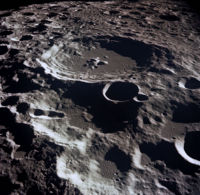 The early days of the Earth were violent times. Today, our solar system is relatively quiet and sedentary, presided over by an aging star that is long past its stormy youth. But 4.5 billion years ago, our sun was just forming its planetary progeny, and things were far from quiet. Huge masses of rock and material, called planetesimals, revolved round the sun in a great disk, colliding, joining, and breaking up again with astonishing energy.
The early days of the Earth were violent times. Today, our solar system is relatively quiet and sedentary, presided over by an aging star that is long past its stormy youth. But 4.5 billion years ago, our sun was just forming its planetary progeny, and things were far from quiet. Huge masses of rock and material, called planetesimals, revolved round the sun in a great disk, colliding, joining, and breaking up again with astonishing energy.
Eventually, the larger bodies began to hold together, and as material agglomerated together, giant impacts became increasingly rare. Sometime during this period of planet formation, our moon was formed. However, the details of just how our moon came to be are still shrouded in mystery. There are several possible theories, but getting all the data to fit any one of them remains a challenge. The question is an important one, for the history of the moon is intricately bound with the history of the earth itself, and the formation of the moon likely had a profound influence on the evolution of life itself. Understanding its provenance is likely to help us understand our own beginnings as well.
Moons are common in our solar system. Of the eight planets that revolve around our sun, only two (Mercury and Venus) do not have at least one moon. They arise naturally from the processes that create planets, and planets themselves (as we are just now learning) are a common and expected consequence of star formation. To date, roughly 1500 planets have been found outside our solar system. While we cannot yet make sensitive enough measurements to tell for sure, we expect many of those planets might also have moons. So, how do moons form?
One way a moon can form is by gravitational capture, wherein a planet captures material that is zipping by into a closed orbit (Marshak, Stephen, Essentials of Geology, 2nd Ed, W. W. Norton, 2007). The captured material can be the entire moon, or many small rocks could be captured and eventually merge to form a moon or moons. While this mechanism is simple and appealing, we know that it cannot work in a system where the planet and the moon are the only two gravitational actors in the system. It becomes feasible if there is a third massive body nearby, and it is thought that one or more moons of Neptune may have been formed in this manner. This is not a good explanation of our moon.
Another way a moon can form is by fission on a planetary scale. Though gravity is a major headache in the search for a grand unified theory, we can at least calculate its effects extremely accurately—well enough, for example, to put an unguided satellite into a trajectory that would eventually take it on multiple slingshot passes around the Earth and Mars over a period of 10 years, and have it end up pulling up along-side a comet only 2 miles wide tumbling through space 40,000 miles per hour! For comparison, your average bullet travels at a leisurely 1,700 miles per hour. Because of that precision in our calculations, we can build precise computer models and run simulations of planet formation based on our known physics and test theories of moon formation.
Using such simulations, we can dismiss the fission model of moon formation. Originally proposed by George Darwin, son of the great biologist, the fission theory postulates that at some time in the past, the planet was spinning faster at the equator than the self-gravity of the planet could withstand, and a chunk of the Earth came off and became the moon. Darwin thought the region now filled by the Pacific Ocean might have been that chuck, based on the fact that the size roughly fits. With the benefit of modern science, we know that the Pacific Ocean is a modern geologic feature born of plate tectonics; more importantly, the moon-Earth system has only about half the angular momentum necessary for this process to have worked.
The most appealing modern theory is the giant impact theory. In this picture, a large (Mars-sized) object hits the early Earth at a glancing angle. This enormous impact would take place over a period of several hours, and the unimaginable heat and energy would vaporize rock and hurtle huge chunks of material into space—with most of that material coming from the impactor (not the Earth). Computer simulations show that such a scenario could explain many of our observations about the moon: the angular momentum is right and the size of the moon can be explained. But there is one nagging problem.
Everything on Earth, from rocks to humans to trees, has a kind of atomic fingerprint, a ratio of one isotope of oxygen to another, which identifies that thing as coming from Earth. If we were ever to suspect an alien in our midst, this would be a convenient way to identify them. Meteorites, Mars, the sun, and anything not from earth shows a significant difference in these ratios of oxygen isotopes. And this is the mysterious part: Isotopic analysis of the moon shows that its rocks are almost exactly the same as that of everything on Earth. But our simulations of giant impact are clear—the majority of the material in the resulting moon is from the impacting body, not the planet. Theories to explain these data have been proposed, but none have been unambiguously shown to be true or been universally accepted. As of today, no one knows the answer to this puzzle.
